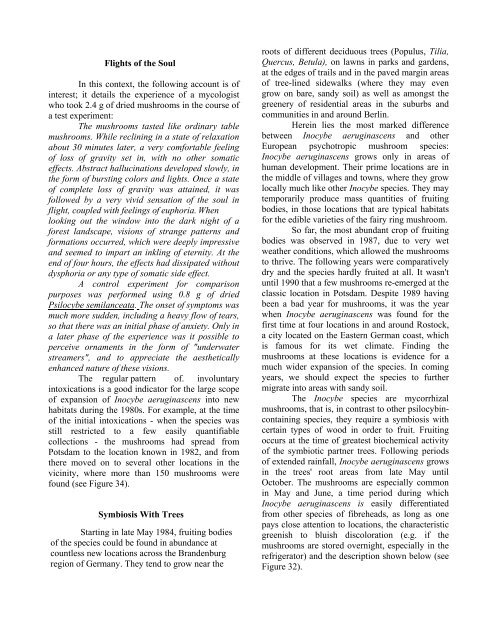Jochen Gartz - Magic Mushrooms Around the ... - preterhuman.net
Jochen Gartz - Magic Mushrooms Around the ... - preterhuman.net
Jochen Gartz - Magic Mushrooms Around the ... - preterhuman.net
Create successful ePaper yourself
Turn your PDF publications into a flip-book with our unique Google optimized e-Paper software.
Flights of <strong>the</strong> Soul<br />
In this context, <strong>the</strong> following account is of<br />
interest; it details <strong>the</strong> experience of a mycologist<br />
who took 2.4 g of dried mushrooms in <strong>the</strong> course of<br />
a test experiment:<br />
The mushrooms tasted like ordinary table<br />
mushrooms. While reclining in a state of relaxation<br />
about 30 minutes later, a very comfortable feeling<br />
of loss of gravity set in, with no o<strong>the</strong>r somatic<br />
effects. Abstract hallucinations developed slowly, in<br />
<strong>the</strong> form of bursting colors and lights. Once a state<br />
of complete loss of gravity was attained, it was<br />
followed by a very vivid sensation of <strong>the</strong> soul in<br />
flight, coupled with feelings of euphoria. When<br />
looking out <strong>the</strong> window into <strong>the</strong> dark night of a<br />
forest landscape, visions of strange patterns and<br />
formations occurred, which were deeply impressive<br />
and seemed to impart an inkling of eternity. At <strong>the</strong><br />
end of four hours, <strong>the</strong> effects had dissipated without<br />
dysphoria or any type of somatic side effect.<br />
A control experiment for comparison<br />
purposes was performed using 0.8 g of dried<br />
Psilocybe semilanceata. The onset of symptoms was<br />
much more sudden, including a heavy flow of tears,<br />
so that <strong>the</strong>re was an initial phase of anxiety. Only in<br />
a later phase of <strong>the</strong> experience was it possible to<br />
perceive ornaments in <strong>the</strong> form of "underwater<br />
streamers", and to appreciate <strong>the</strong> aes<strong>the</strong>tically<br />
enhanced nature of <strong>the</strong>se visions.<br />
The regular pattern of. involuntary<br />
intoxications is a good indicator for <strong>the</strong> large scope<br />
of expansion of Inocybe aeruginascens into new<br />
habitats during <strong>the</strong> 1980s. For example, at <strong>the</strong> time<br />
of <strong>the</strong> initial intoxications - when <strong>the</strong> species was<br />
still restricted to a few easily quantifiable<br />
collections - <strong>the</strong> mushrooms had spread from<br />
Potsdam to <strong>the</strong> location known in 1982, and from<br />
<strong>the</strong>re moved on to several o<strong>the</strong>r locations in <strong>the</strong><br />
vicinity, where more than 150 mushrooms were<br />
found (see Figure 34).<br />
Symbiosis With Trees<br />
Starting in late May 1984, fruiting bodies<br />
of <strong>the</strong> species could be found in abundance at<br />
countless new locations across <strong>the</strong> Brandenburg<br />
region of Germany. They tend to grow near <strong>the</strong><br />
roots of different deciduous trees (Populus, Tilia,<br />
Quercus, Betula), on lawns in parks and gardens,<br />
at <strong>the</strong> edges of trails and in <strong>the</strong> paved margin areas<br />
of tree-lined sidewalks (where <strong>the</strong>y may even<br />
grow on bare, sandy soil) as well as amongst <strong>the</strong><br />
greenery of residential areas in <strong>the</strong> suburbs and<br />
communities in and around Berlin.<br />
Herein lies <strong>the</strong> most marked difference<br />
between Inocybe aeruginascens and o<strong>the</strong>r<br />
European psychotropic mushroom species:<br />
Inocybe aeruginascens grows only in areas of<br />
human development. Their prime locations are in<br />
<strong>the</strong> middle of villages and towns, where <strong>the</strong>y grow<br />
locally much like o<strong>the</strong>r Inocybe species. They may<br />
temporarily produce mass quantities of fruiting<br />
bodies, in those locations that are typical habitats<br />
for <strong>the</strong> edible varieties of <strong>the</strong> fairy ring mushroom.<br />
So far, <strong>the</strong> most abundant crop of fruiting<br />
bodies was observed in 1987, due to very wet<br />
wea<strong>the</strong>r conditions, which allowed <strong>the</strong> mushrooms<br />
to thrive. The following years were comparatively<br />
dry and <strong>the</strong> species hardly fruited at all. It wasn't<br />
until 1990 that a few mushrooms re-emerged at <strong>the</strong><br />
classic location in Potsdam. Despite 1989 having<br />
been a bad year for mushrooms, it was <strong>the</strong> year<br />
when Inocybe aeruginascens was found for <strong>the</strong><br />
first time at four locations in and around Rostock,<br />
a city located on <strong>the</strong> Eastern German coast, which<br />
is famous for its wet climate. Finding <strong>the</strong><br />
mushrooms at <strong>the</strong>se locations is evidence for a<br />
much wider expansion of <strong>the</strong> species. In coming<br />
years, we should expect <strong>the</strong> species to fur<strong>the</strong>r<br />
migrate into areas with sandy soil.<br />
The Inocybe species are mycorrhizal<br />
mushrooms, that is, in contrast to o<strong>the</strong>r psilocybincontaining<br />
species, <strong>the</strong>y require a symbiosis with<br />
certain types of wood in order to fruit. Fruiting<br />
occurs at <strong>the</strong> time of greatest biochemical activity<br />
of <strong>the</strong> symbiotic partner trees. Following periods<br />
of extended rainfall, Inocybe aeruginascens grows<br />
in <strong>the</strong> trees' root areas from late May until<br />
October. The mushrooms are especially common<br />
in May and June, a time period during which<br />
Inocybe aeruginascens is easily differentiated<br />
from o<strong>the</strong>r species of fibreheads, as long as one<br />
pays close attention to locations, <strong>the</strong> characteristic<br />
greenish to bluish discoloration (e.g. if <strong>the</strong><br />
mushrooms are stored overnight, especially in <strong>the</strong><br />
refrigerator) and <strong>the</strong> description shown below (see<br />
Figure 32).








![The Big Lie 9-11 and Government Complicity in Mass Murder [PDF]](https://img.yumpu.com/50957077/1/190x245/the-big-lie-9-11-and-government-complicity-in-mass-murder-pdf.jpg?quality=85)








